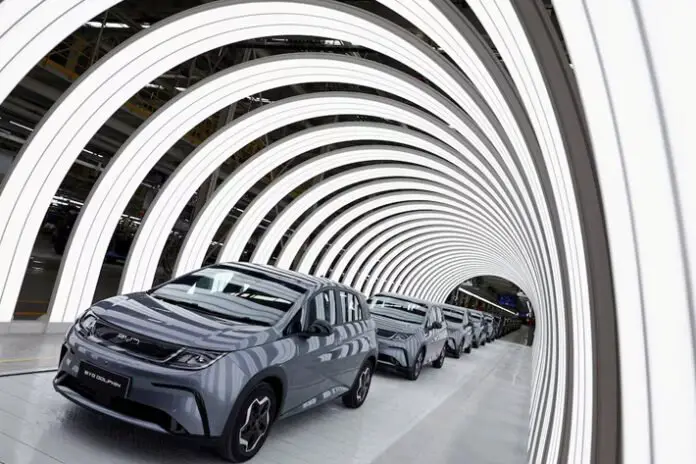Staff Reporter
As the Year of the Snake begins, electric vehicle (EV) manufacturers in China are launching aggressive incentives to attract consumers, following a decline in deliveries reported by major automakers.
Concerns have arisen over softening consumption indicators in China, sparking fears that automakers may struggle to sell their growing inventory. Liz Lee, associate director at Counterpoint Research, noted, “Around the Chinese New Year holidays, we saw these aggressive promotions emerge. It remains to be seen how long they will last.”
The Lunar New Year holiday, celebrated from January 28 to February 4, marked the start of the snake year in the Chinese zodiac. In January, the Chinese government announced it had allocated 81 billion yuan (approximately $11.12 billion) to stimulate consumption across various sectors, including electric cars, smartphones, and home appliances.
On the first official working day post-holiday, Tesla unveiled an 8,000 yuan insurance subsidy alongside a five-year interest-free financing option for its most affordable model, the Model 3. This offer effectively reduces the total price of the base version by nearly $1,100 for customers who make a 34% down payment of around $11,000 this month. Customers opting for a lower down payment will incur interest charges.
Additionally, Tesla announced a similar five-year interest-free financing plan for its upcoming Model Y, set to begin deliveries in March. Despite achieving record sales in China last year, the U.S. automaker has acknowledged the rising competitive pressures in the market.
Chinese electric vehicle startup Xpeng has made headlines by eliminating down payments entirely while offering a five-year, interest-free financing option for four of its models. The company proudly highlighted on social media that it is the only automaker providing a zero down payment plan alongside 0% interest. Previously, Xpeng had waived the down payment for its G6 SUV during a promotional sale in December.
In a parallel move, Nio announced on February 1 a five-year, 0% interest financing plan following a notable drop in sales, with total deliveries plummeting to 13,863 units in January, down from 31,138 in December. This new offer marks an upgrade from Nio’s earlier three-year, 0% interest loan program launched in January.
Competitor Li Auto also joined the trend, unveiling a three-year, 0% interest financing plan in November.
These latest incentives are considered “significant” and represent a strategy to reduce costs without directly lowering vehicle prices, according to Stephen Dyer, partner and managing director at AlixPartners, who co-leads the firm’s Greater China operations. Dyer noted, however, that unlike consumers in North America, Chinese buyers often hesitate to embrace price reductions, opting instead to wait for even deeper discounts.
Amid seasonal pressures, several major Chinese electric vehicle companies reported a stark decline in domestic deliveries in January compared to December. BYD, the market leader, experienced a drop in passenger vehicle sales from 509,440 in December to 296,446 in January. Analysts anticipate slower growth in the industry after years of rapid expansion.
“There is a little bit of shakeout starting now,” Dyer remarked. “I wouldn’t be surprised to see even more shakeout this year as volumes continue to be under pressure.”
The slowdown in China’s automotive market is intensifying competition, particularly as local manufacturers aggressively slash prices. Traditional foreign brands are struggling to keep pace with the rapid shift toward new energy vehicles (NEVs), which include battery-only and hybrid cars. NEVs now represent over half of all new passenger cars sold in China.
According to projections from Counterpoint Research, the share of new energy vehicles in China’s passenger car market is expected to rise from around 50% this year to an astounding 86% by 2035.
Analyst Liz Lee predicts that more international brands will soon introduce their own incentives to attract Chinese car buyers. However, she anticipates these promotions will only last one or two months, with local brands ultimately emerging as the market leaders.
Last year, the competitive landscape saw 20 new energy vehicle brands cease operations in China, while 13 new brands entered the market, resulting in a net decline of seven brands. Dyer reports that most of the new entrants and those shutting down were Chinese companies, suggesting that U.S. automakers may soon face increased pressures.
The challenge extends beyond China’s borders. Ford Motor Company reported earnings of $600 million in China last year and announced that its regional head would also oversee its international markets group.

